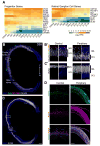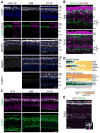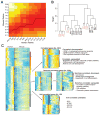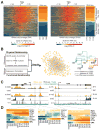Molecular Anatomy of the Developing Human Retina
- PMID: 29233477
- PMCID: PMC5776731
- DOI: 10.1016/j.devcel.2017.10.029
Molecular Anatomy of the Developing Human Retina
Abstract
Clinical and genetic heterogeneity associated with retinal diseases makes stem-cell-based therapies an attractive strategy for personalized medicine. However, we have limited understanding of the timing of key events in the developing human retina, and in particular the factors critical for generating the unique architecture of the fovea and surrounding macula. Here we define three key epochs in the transcriptome dynamics of human retina from fetal day (D) 52 to 136. Coincident histological analyses confirmed the cellular basis of transcriptional changes and highlighted the dramatic acceleration of development in the fovea compared with peripheral retina. Human and mouse retinal transcriptomes show remarkable similarity in developmental stages, although morphogenesis was greatly expanded in humans. Integration of DNA accessibility data allowed us to reconstruct transcriptional networks controlling photoreceptor differentiation. Our studies provide insights into human retinal development and serve as a resource for molecular staging of human stem-cell-derived retinal organoids.
Keywords: development; fetal; fovea; gene network; human; macula; organoids; photoreceptor; retina; transcriptome.
Copyright © 2017 Elsevier Inc. All rights reserved.
Figures








Similar articles
-
Improved Retinal Organoid Differentiation by Modulating Signaling Pathways Revealed by Comparative Transcriptome Analyses with Development In Vivo.Stem Cell Reports. 2019 Nov 12;13(5):891-905. doi: 10.1016/j.stemcr.2019.09.009. Epub 2019 Oct 17. Stem Cell Reports. 2019. PMID: 31631019 Free PMC article.
-
Early differentiation of ganglion, amacrine, bipolar, and Muller cells in the developing fovea of human retina.J Comp Neurol. 1990 Jan 8;291(2):203-19. doi: 10.1002/cne.902910205. J Comp Neurol. 1990. PMID: 2298931
-
Delayed neurogenesis with respect to eye growth shapes the pigeon retina for high visual acuity.Development. 2016 Dec 15;143(24):4701-4712. doi: 10.1242/dev.138719. Epub 2016 Nov 11. Development. 2016. PMID: 27836962
-
The developing and evolving retina: using time to organize form.Brain Res. 2008 Feb 4;1192:5-16. doi: 10.1016/j.brainres.2007.07.005. Epub 2007 Jul 14. Brain Res. 2008. PMID: 17692298 Review.
-
Understanding the complexity of retina and pluripotent stem cell derived retinal organoids with single cell RNA sequencing: current progress, remaining challenges and future prospective.Curr Eye Res. 2020 Mar;45(3):385-396. doi: 10.1080/02713683.2019.1697453. Curr Eye Res. 2020. PMID: 31794277 Free PMC article. Review.
Cited by
-
Multi-omics analysis in human retina uncovers ultraconserved cis-regulatory elements at rare eye disease loci.Nat Commun. 2024 Feb 21;15(1):1600. doi: 10.1038/s41467-024-45381-1. Nat Commun. 2024. PMID: 38383453 Free PMC article.
-
Characterization and Transplantation of CD73-Positive Photoreceptors Isolated from Human iPSC-Derived Retinal Organoids.Stem Cell Reports. 2018 Sep 11;11(3):665-680. doi: 10.1016/j.stemcr.2018.07.005. Epub 2018 Aug 9. Stem Cell Reports. 2018. PMID: 30100409 Free PMC article.
-
Thyroid hormone signaling specifies cone subtypes in human retinal organoids.Science. 2018 Oct 12;362(6411):eaau6348. doi: 10.1126/science.aau6348. Science. 2018. PMID: 30309916 Free PMC article.
-
Self-Organization of the Retina during Eye Development, Retinal Regeneration In Vivo, and in Retinal 3D Organoids In Vitro.Biomedicines. 2022 Jun 20;10(6):1458. doi: 10.3390/biomedicines10061458. Biomedicines. 2022. PMID: 35740479 Free PMC article. Review.
-
Epigenetics in neuronal regeneration.Semin Cell Dev Biol. 2020 Jan;97:63-73. doi: 10.1016/j.semcdb.2019.04.001. Epub 2019 May 9. Semin Cell Dev Biol. 2020. PMID: 30951894 Free PMC article. Review.
References
-
- Bumsted O’Brien KM, Cheng H, Jiang Y, Schulte D, Swaroop A, Hendrickson AE. Expression of photoreceptor-specific nuclear receptor NR2E3 in rod photoreceptors of fetal human retina. Investigative ophthalmology & visual science. 2004;45:2807–2812. - PubMed
-
- Cayouette M, Poggi L, Harris WA. Lineage in the vertebrate retina. Trends Neurosci. 2006;29:563–570. - PubMed
Publication types
MeSH terms
Substances
Grants and funding
LinkOut - more resources
Full Text Sources
Other Literature Sources
Molecular Biology Databases

